The Multiple Standpoints of Hassan Khan
What may seem erratic, disparate, schizophrenic, and impatient might instead be read as a thoughtful, methodical, and relentless reconstruction of, as Hassan puts it, his process of defining the sum total of knowledge.
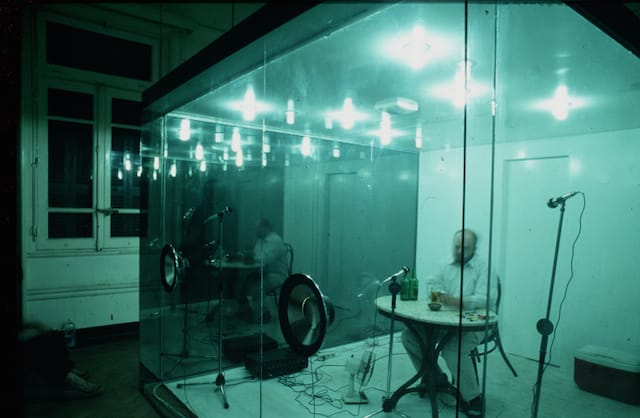
I have known Hassan Khan since 1999. I’ve worked with him twice, having curated the Egypt portion of L’Art dans le monde (2000) in Paris that included a presentation of his video installation “re/lapse” (2000), and a deep dive into his work during graduate school culminating with the installation of “to the man masturbating in the toilet of the Charles De Gaulle airport” in my thesis exhibition Four by Four (2005) at Artists Space in New York. Hassan operates in gallery space, public space, the museum, and the international biennale circuit. He writes and he publishes widely. In each instance, he is drafting and performing new terms of engagement, new paradigms for human encounter.
This artist demonstrates through action and words the rare ability to articulate a feeling, a situation, and an idea from multiple standpoints. He develops strikingly complex projects rupturing the way messages are formed and transmitted, for instance the four channel video installation “The Hidden Location” (2004). This is one among dozens he has developed and presented that can be undressed to reveal an armature formed through his orchestration of antagonistic elements, which in this instance include contexts (office, street, domestic space), monographic dialogues, and the actors. Hassan’s desire to study and generate aesthetic forms and environments that point to processes of knowledge creation surfaced prominently over the course of our three-session chat in late March.
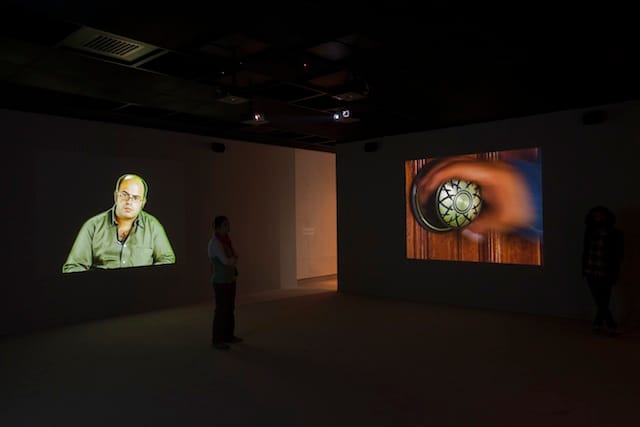
This has been an important year for Hassan. He is a finalist for the prestigious Hugo Boss Award that will be announced this fall. He is in good company with Paul Chan (b. 1973, Hong Kong), Sheela Gowda (b. 1957, Bhadravati, India), Camille Henrot (b. 1978, Paris) and Charline von Heyl (b. 1960, Mainz, Germany). Equally significant was his first solo show in Cairo in eleven years at D-CAF — Downtown Contemporary Arts Festival that ran from March 31 to April 26. The curator, Beth Styker, decided to put emphasis on ways Hassan uses narrative structures to draw our attention to the importance of language.
This exhibition featured seminal works such as the light and sound installation “DOM TAK TAK DOM TAK” (2005) innovatively installed in a storefront along the Kodak Passageway, a display of the objects and wall text comprising “The Agreement” (2011), texts transcribed onto walls including Mahmoud El-Ansari (2010), and the artist book that resulted from the installation “17 and in AUC” (2003).
“The Twist” (2012/2013) and “Banque Bannister” (2010) are sculptures made from hearty, weatherproof material — stainless steel and brass respectively — with explicit references through their form — literally a knot and a bank banister — that orient the viewer and evoke conversation about the linguistic function of specific forms that build our social and physical environment.
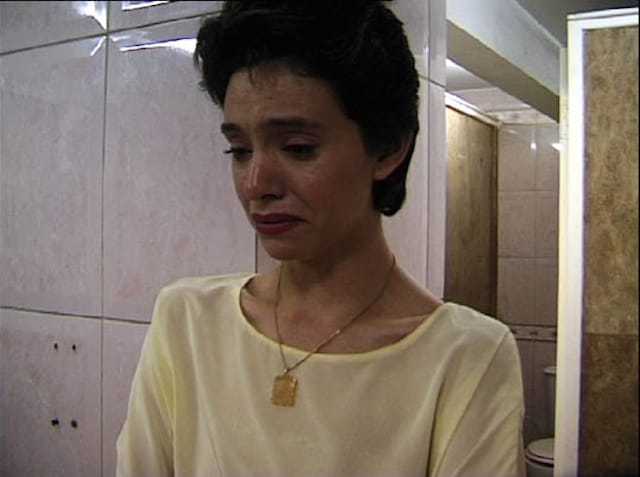
We conducted our conversation leading up to and during the D-CAF installation period. This conversation is long. It spans three one-hour sessions and discusses in depth many works from Hassan’s career with a raw clarity. The chat format garnered crisp, honest insights that help elucidate some of the contradictory and obtuse aspects of Hassan’s work.
* * *
8:55am
Yasmeen Siddiqui
Let’s start with your project Compositions for A Public Park (2013) in Paris for Nuit Blanche. I am
interested in how the site was selected. And then we’ll delve into the content. Tell me about
how the project took its form.
8:56am
Hassan Khan
I was invited to participate in Nuit Blanche a few short months before the event
they sent me choices of possible spaces
including the park and other possibilities
I liked it the most
but they also wanted me there
so we kind of were in agreement
8:57am
Yasmeen Siddiqui
What were the other sites?
8:57am
Hassan Khan
a theater a church a sports center
something like that
some open public pedestrian spaces by the river
the festival takes place in public spaces all over the city for one night

8:58am
Yasmeen Siddiqui
Describe the park in contrasts with the other sites. What attracted you?
8:58am
Hassan Khan
They wanted me to do a concert and screen some videos or something like that for the whole
night
That’s exactly what I didn’t want to do
The park just seemed more enticing, particularly its relation to the public more immediate and
less moderated
8:59am
Yasmeen Siddiqui
You resist being an entertainment center to bolster local tourism
8:59am
Hassan Khan
Ha
That also has something to do with how I approached this piece because I wanted it to engage
an audience in a way that didn’t have to go through the filter of “art”
but I didn’t want it to be merely entertainment
there had to be some grain
some traction
something that resists easy consumption
but that should also be communicable
hence the texts
9:01am
Yasmeen Siddiqui
The libretto is powerful and moving. I would like to know more about its root and what you are
tapping into.
9:01am
Hassan Khan
If it was just the music and the lights it would have been beautiful and enjoyable but just an
ambience in the end
I wanted to find a place where the people visiting the park can recognize something
For instance, they can recognize the voice they hear as possibly someone they know, someone
they can be, someone they were, someone the are afraid of, or love.
But not to do that through identification
The voice is not the hero it’s possibly a voice you may hear inside your head
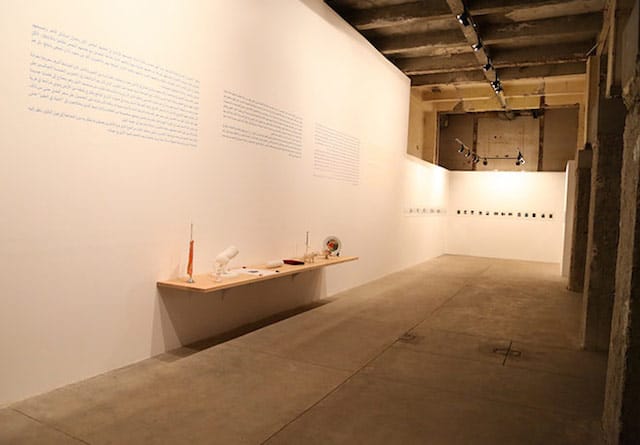
9:03am
Yasmeen Siddiqui
Do you feel you have accessed an experience, a feeling, a story that transcends disparate
communities with this piece through its content and composition?
9:03am
Hassan Khan
The libretto was recorded in the voice of a man and a woman
Each text is located in a different segment of the park
9:03am
Yasmeen Siddiqui
Why the voice inside your head.
9:04am
Hassan Khan
I knew that if I was to engage the voice inside my head, which is a refraction of the voices
outside of my head, then I would probably strike something that is recognizable without
claiming to be anywhere
and therefore the texts were written in an elastic fashion
The “I” keeps shifting
It’s not very clear who is speaking, at least, in movements 2 and 3
9:04am
Yasmeen Siddiqui
This is a work that I understand as standing apart in the context of your expansive production
9:05am
Hassan Khan
It stands apart because of its nature as a public piece
I don’t think it stands apart in its concerns
or in its process
or in what it worries about
9:05am
Yasmeen Siddiqui
Tell me about your interest in literature. Who do you read, what moves you. Am I correct that
you studied literature?
9:05am
Hassan Khan
Yes I have a BA and an MA in English and Comparative Literature
I don’t read much any more!
I used to a long time ago
I’ve been trying to go beyond the first hundred pages of the Brother Karmazov for a couple of
years now
Although it’s amazing
I can’t seem to be able to just keep going

9:06am
Yasmeen Siddiqui
Hold on for a second. Let’s move back to your assertion that this is not a shift – except in the
context of public display
9:07am
OK
In any case writing plays a big role in my work
in the coming exhibition in Cairo
there are a lot of text and narrative pieces
but its just an aspect
The curator is Beth Stryker and she is the one who was highly interested in making that thread
prominent.
Although I can easily put another show together that would make it very minor and make
something else prominent
The space is four spaces, storefront spaces off the Kodak passageway on Adly Street downtown
The spaces were in terrible condition but have been beautifully renovated by CLUSTER
9:15am
Yasmeen Siddiqui
Well, I am pleased that you have made this choice. Let’s discuss the politics behind your
decision. What are your investments and current focus on narrative

9:16am
Hassan Khan
I have always been interested in narrative but I’ve made it more explicit lately
Chapter II is from 2007 and is a sort of disguised fragment
Mahmoud Al-Ansari is from 2010
9:16am
Yasmeen Siddiqui
How do you build narratives?
9:18am
Hassan Khan
In 2011 I was invited by Mai Abu El Dahab who was then the curator at Objectif Exhibitions to do
an exhibition there
At the time I felt a very strong desire and need to write narratives
Two works were born out of this engagement in the same year
The first was Mystery.
Mai invited me to do a performance at some meeting of different sister institutions they had
And I did a piece called A short story based upon a distant memory with a long musical interlude
(the text is published on page 24) http://www.macba.cat/uploads/20111122/02_ang.pdf
And in that piece I read an introduction, which discusses what I am doing and how I work and
why and then I begin a story, which is a sort of “sublimation,” which is an example of what I was
trying to describe
And then at one point I stop the story and perform a piece of music that I had composed for that
piece (here is an excerpt from the composition being performed in a concert as a stand alone
music piece: https://www.youtube.com/watch?v=R80FKYUerYQ ) and then go back and finish
the storyFor the exhibition itself which was a few months later
I produced “The Agreement”
In that same year, I made another two works very much motivated by narrative
I think the desire might have abated a bit
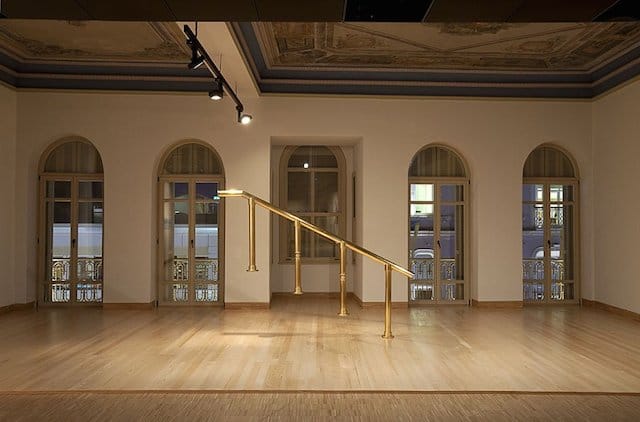
9:22am
Yasmeen Siddiqui
Have you studied music formally?
9:22am
Hassan Khan
No
9:23am
Yasmeen Siddiqui
Do you like Opera?
9:23am
Hassan Khan
No, but have never really tried listening to it seriously
It made sense for Composition for a Public Park
9:23am
Yasmeen Siddiqui
What intrigues you about the intersection of narrative and music
9:23am
Hassan Khan
I think it is something else that I am interested in, which is “modulation”
Seeing things in two different ways at the same time
For example, a short story based on a distant memory with a long musical interlude is structured
as two experiences
A text and then a concert and then a text
When you return to the text it has completely changed because of the experience of the music
Yasmeen Siddiqui
With these multiple vantage points, do you use modulation as a lure
9:24am
Hassan Khan
I should explain that the musical piece is very emotional
Not as a lure but rather the actual moment
Something changes
The transformation from one condition to the next is important
I am not sure how or why exactly but I am drawn to it
To sometimes treating it coldly
For example I don’t know if you’ve seen my project in Artforum trusted sources (http://artforum.com/inprint/issue=201308&id=43120)
Each page is a different work
The works might not be cold
But the list is
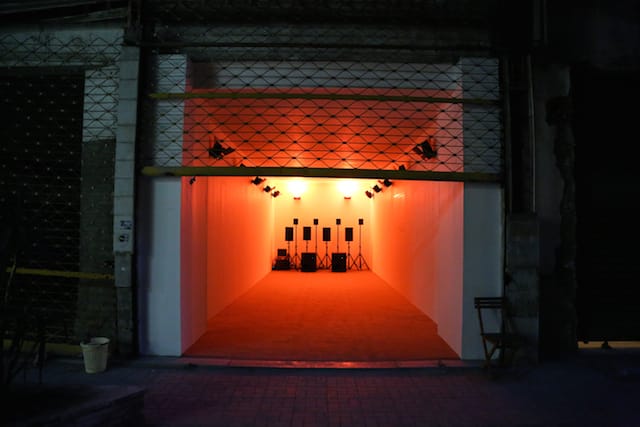
9:35am
Yasmeen Siddiqui
If you are exploring the possibilities of holding multiple views how does this operate in your
work and in your life
9:35am
Hassan Khan
Multiple views for me is not about having different opinions or positions
9:36am
Hassan Khan
It’s about literally seeing two things at the same time
Like a mountain and a sea
As if each eye is independent of the other
In a way, it’s more literal
9:36am
Yasmeen Siddiqui
That seems highly contradictory
9:37am
Hassan Khan
When I say that I also don’t mean it literally
It makes sense to me as an aspiration maybe
Both my eyes usually see the same thing – maybe with a minimal difference in angle
But when it comes to the field of the work
It is possible to function “as if”
That is a possible condition
It’s maybe even productive to do that
9:38am
Hassan Khan
So in trusted sources the modulation is the fact that you jump from piece to piece
The coldness I referred to is in that not necessarily in the content
But in the “list”
Like in DOM TAK TAK DOM TAK from 2005, which I also show in the exhibition
The automated room
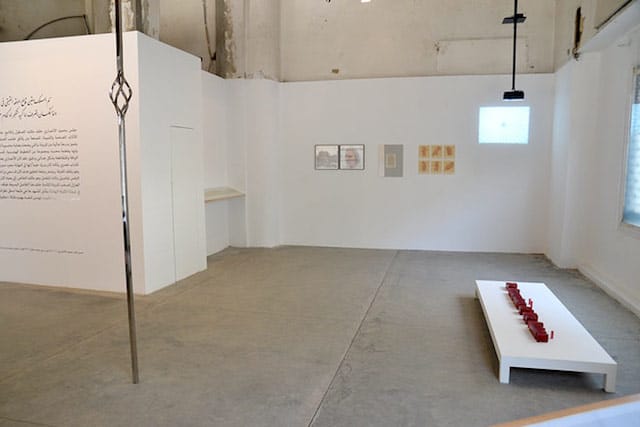
9:40am
Yasmeen Siddiqui
Do you believe in free-will
9:40am
Hassan Khan
You are not going to get a straight answer. I do usually say that that is a question….
Actually its at the heart of DOM TAK
9:41am
Yasmeen Siddiqui
I know
9:41am
Hassan Khan
Again, I usually refer to it as being concerned with the “cold heart of culture” ( http://
english.ahram.org.eg/NewsContent/5/25/97750/Arts–Culture/Visual-Art/DCAF-presents-
two-decades-of-Hassan-Khan.aspx )
9:41am
Yasmeen Siddiqui
It is effectively installed in the current exhibition, in a storefront facing Kodak Passageway.
9:41am
Hassan Khan
It is a productive location. I am wanting to “touch the cold heart of culture” and I am quoting
myself from several places here
So I’ve used this formulation over and over
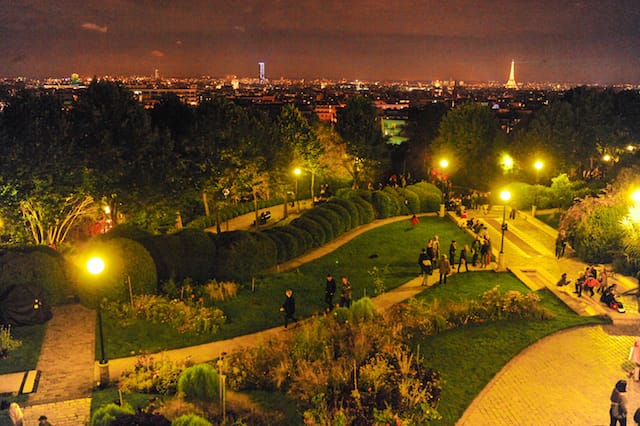
9:41am
Yasmeen Siddiqui
Why are you so fixated, obsessed?
9:42am
Hassan Khan
I am??
9:42am
Yasmeen Siddiqui
I did not want to use those words.
No, you are rigorously tapping the issue.
9:42am
Hassan Khan
But is it that rigorous
I leave lots of space for mistakes
9:42am
Yasmeen Siddiqui
Then, relentless
9:43am
Hassan Khan
And weird desires as well
Sudden swerves
OK
Maybe relentless
I don’t know
yes
Pounding at something
It’s funny because a lot of people think I am completely inconsistent
9:43am
Yasmeen Siddiqui
I have a different experience with what I have seen of your work, which is not all of it. That
might be one of the strengths of the current show, putting emphasis on the ways you construct
narrative as an ever-present strand
9:44am
Hassan Khan
It seems to me that I’ve been incredibly consistent almost since childhood
But I modulate in a funny way
I guess there is a meta-narrative here
9:44am
Yasmeen Siddiqui
Yes, and that is what I want to articulate
9:44am
Hassan Khan
If I look at my work from around 94/95 till now
9:45am
Yasmeen Siddiqui
Just before I met you
9:45am
Hassan Khan
Yes
It starts and stops spins around and moves forward
forms change
approaches change
aesthetics transform
but
there is some core
that is not
a theme
or an issue
or an aesthetic etc
its something else
which remains
and that is the “relentless” you mention

9:46am
Yasmeen Siddiqui
Unsaid
9:46am
Hassan Khan
but actually what I wanted to say
is that if these 19 years are spread out
the way they modulate is maybe similar to how things modulate inside some works at least
like a mirror structure
this is not very tight
cause its only relevant to some work
9:48am
Yasmeen Siddiqui
A loose mirror structure that permeates some or much of your work
I do not get this paradigm. Give me something to hang the concept on
9:49am
Hassan Khan
OK, I am going to send you now a word document, which was my contribution to GAGARIN
(http://www.gagarin.be/back_issues/artist/207)
I went through my notebooks from the early 90s to the present and made a selection of phrases
etc
It is a publication that publishes unpublished stuff by artists
Don’t know if this helps explain that mirror structure
Or maybe we need to think about the “unsaid” you mentioned
9:52am
Yasmeen Siddiqui
The unsaid – is that the feeling – the anxiety?
9:54am
Hassan Khan
I do not know if anxiety is accurate
The unsaid is the consistency that we discussed
it takes me back to our discussion of The Hidden Location, around, I guess, ten years ago
9:55am
Yasmeen Siddiqui
Wow – yes, that takes me back. That work is densely packed with content. The work is organized
by four projections. There are sixteen stories that intertwine and interrelate through the action
of viewing the installation. New Yorker’s got lucky, as it was in your recent Queens Museum
exhibition (https://www.youtube.com/watch?v=UqbbOYA5KpE). It was supposed to be in my
thesis show in 2005, but it broke my budget. Regardless, our conversation about the piece was
fruitful.
Hassan Khan
Yes
We discussed what that “hidden location” was or what it meant
9:56am
Yasmeen Siddiqui
Bingo!
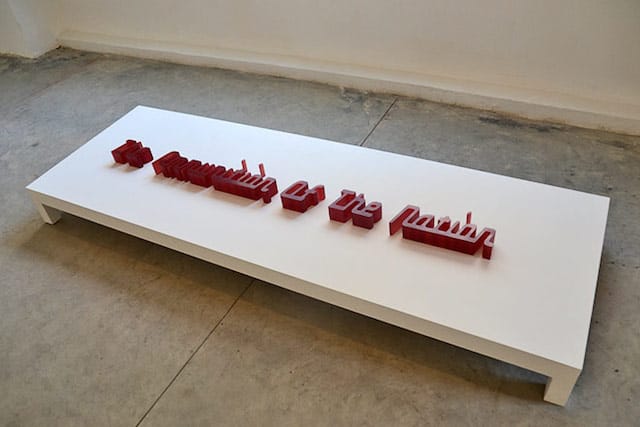
9:56am
Hassan Khan
I was thinking of that
And how it is similar to what we are describing here, “the unsaid”
9:57am
Yasmeen Siddiqui
Full circle
9:57am
Hassan Khan
But maybe not
Maybe this is the lazy way out and we should develop something else
9:57am
Yasmeen Siddiqui
I have to find the precise words to get at what many pages got at in our last interview. We can
go in a new direction once we recall that point.
9:58am
Hassan Khan
Yes
But I am going to suggest we continue tomorrow
* * *
Our conversation did continue. Over the subsequent two sessions we exchanged a multitude of ideas about knowledge, its formations and formulations. In the process, Hassan mapped the steps he took to create several artworks as well as recent texts, specifically Mystery, Nine Lessons Learned From Sherif Al Azma, In Defense of the Corrupt Intellectual, A Monster Was Born, and The Knot.
We discussed literary genres and how he extrapolates meanings from the structure of expression employed in lowbrow mystery novellas written for boys. This moment was critical to the overarching conversation. What began to surface can be expressed in summation as Hassan’s Ontology; we were able to tackle some of the strategies he employs to articulate his existence.
For twenty years and counting, via all means possible (video, writing, sculpture, performance, music installation), Hassan has proposed and re-proposed, broken apart and rebuilt material and conceptual frameworks for the creation and dissemination of social, political, and cultural information. What may seem erratic, disparate, schizophrenic, and impatient might instead be read as a thoughtful, methodical, and relentless reconstruction of, as Hassan puts it, his process of defining the sum total of knowledge.




